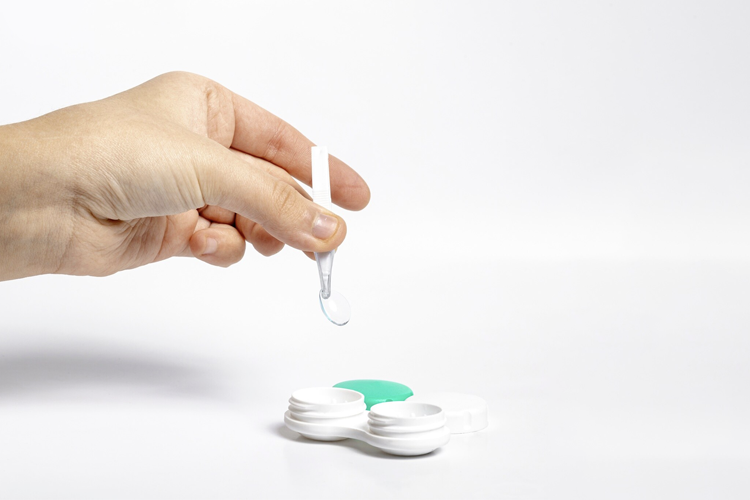Contact lenses have brought immense convenience to many people's lives, but the challenge of removing protein deposits from lenses remains a persistent issue. While regular cleaning solutions can remove surface debris to some extent, under a microscope, white deposits composed of proteins, lipids, calcium salts, and microorganisms are still clearly visible. Among these, protein deposits are particularly problematic.
Interestingly, in response to the difficulties associated with protein removal from contact lenses, Japan introduced a law in April 2015 prohibiting the sale of contact lenses with a replacement cycle longer than one month. This led to a surge in the use of daily disposable soft contact lenses. However, the number of eye diseases related to improper contact lens care did not decrease as expected; instead, it increased. In recent years, Japan has reintroduced the sale of longer replacement cycle lenses, including those with a six-month cycle.
What Are the Deposits on Contact Lenses?
Tears contain proteins and other components that are the primary sources of deposits on contact lenses. Normal tears are composed of a complex mixture of over 60 proteins and peptides, electrolytes, enzymes, lipids, metabolites, and mucus. These proteins, including lysozyme, albumin, PMFA (proteins that migrate ahead of albumin during electrophoresis), lactoferrin, IgG, IgA, and mucin, play crucial roles in maintaining the viscosity of tears and providing antimicrobial protection.
When contact lenses come into close contact with the surface of the eye, the eye's immune and rejection responses can increase the levels of lysozyme, immunoglobulins, and lactoferrin in tears (denatured protein deposits can contain up to 87% lysozyme). Some of these tear proteins adhere to the surface of the lenses and can become trapped in the porous structure of the lenses. Over time, these pores become clogged, leading to the formation of protein deposits.
The Impact of Protein Deposits on Contact Lenses
Protein deposits can block the oxygen-permeable pores of the lenses, leading to corneal hypoxia, which can cause eye redness and dryness. When the pores of the lenses are blocked by protein deposits, the amount of oxygen reaching the eye decreases, leading to hypoxia. This can cause the eyes to become red and dry, resulting in blurred vision. In response, new blood vessels may form at the edge of the cornea, and the capillaries in the white of the eye may become more prominent, leading to the appearance of bloodshot eyes.
Hardened protein deposits can damage the cornea and may also trigger allergic reactions. Over time, unremoved protein deposits can become hard and form bumps on the surface of the lenses, causing discomfort similar to having grit in the eye. This can lead to corneal damage from the mechanical action of the lenses. Denatured proteins can also trigger allergic reactions, such as giant papillary conjunctivitis.
The variety of protein deposits on lenses can promote bacterial growth, increasing the risk of eye infections. The proteins left on lenses can encourage the adhesion of various bacteria, leading to eye infections. For example, lysozyme can increase the adhesion of Staphylococcus aureus, and lactoferrin can increase the adhesion of both Staphylococcus aureus and Pseudomonas aeruginosa.
Why Is It So Hard to Remove Protein from Contact Lenses?
Many contact lens wearers are unaware that their lenses need protein removal. Some might believe that soaking lenses in cleaning solution is enough to keep them clean. However, while cleaning solutions can provide some cleaning benefits, their protein removal efficiency is generally low. Data shows that the protein removal rate of most cleaning solutions on the market is as low as 6%, and even high-quality solutions can only achieve a protein removal rate of around 20% for silicone hydrogel lenses, which offer the best comfort.
Some may wonder if soaking lenses longer would help. Unfortunately, no matter how long you soak the lenses, it won't completely remove protein deposits. Hand scrubbing is often recommended as an important step in the cleaning process, but even with scrubbing, new contaminants can be introduced if hand hygiene isn't maintained. While soaking in cleaning solution and hand scrubbing can remove some surface deposits, they are less effective against the protein deposits embedded deep in the porous structure of the lenses.
However, the ReO2 Contact Lens Cleaner uses the principle of "protein electrophoresis" from biomedical science, creating an electric field in the cleaning chamber. This field leverages the charged movement of proteins in the electric field, allowing it to penetrate the porous structure of contact lenses and remove the obstructive proteins. The "electrochemical dissociation" principle then breaks down the physiological saline to produce a chlorine-containing solution, which further splits the peptide bonds of proteins, breaking down large protein molecules into smaller ones. This makes it easier for the electric field to pull the proteins out, achieving highly effective protein removal.
With its patented technology, the ReO2 Contact Lens Cleaner can effectively remove stubborn protein deposits from lenses when used with a simple 0.9% NaCl solution or a multipurpose solution. FDA-approved, it boasts a protein removal rate of up to 94.7% and a bacteria elimination rate of 99.999%, providing a hassle-free and efficient way to clean your contact lenses.


